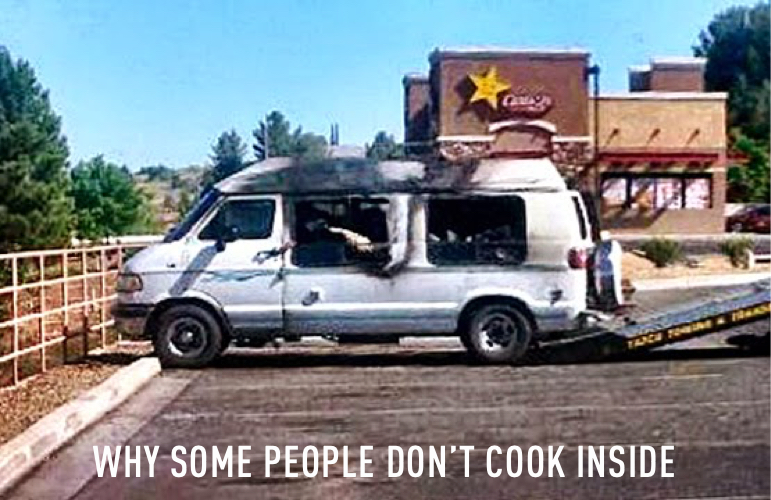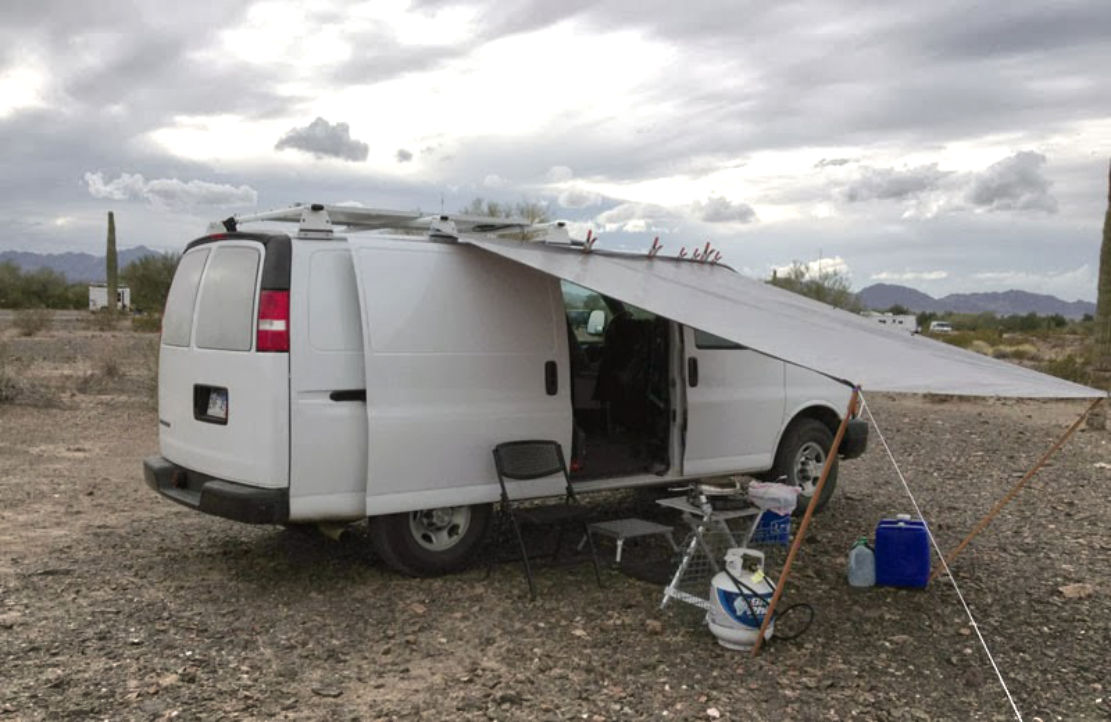
WHEN I STARTED MY NOMAD LIFE nine years ago I swore I would never cook inside my van. I didn’t want an open flame in the middle of so much combustable stuff. I didn’t want the added heat (I had started out in summer). I didn’t want the steam. I didn’t want the splatters or spills. I didn’t want lingering food odors.
So I always set up outside. A small folding table, a single burner stove, a shield against the wind, a propane tank. Perfect. Until it rained. Until there were swarms of insects. Until the daylight hours shortened and I was trying to make dinner in the dark. Until it got cold.
Hmmm… Okay, maybe I’d cook inside just this once, because the rain is coming down sideways. I put the stove on the floor, opened the windows a crack, and played chef. It was more convenient. It was more comfortable. And it was pretty much the end of my outside kitchen. I still cook inside even when the weather is great. Everything I need is within reach. No more climbing in and out of the van to retrieve forgotten ingredients or utensils.

Cooking inside isn’t always possible
Some vehicle dwellers have made commitments to outdoor cooking that can’t be so easily changed. They might be cooking with wood or charcoal. They might have their kitchen built at the rear hatch. They might have an entire kitchen that slides out the back from under the bed. Or there might simply be no room for indoor cooking.

What to do?
During part of my outdoor cooking days I set up a tarp with one side attached to my van. It kept the rain and excessive sun off my little outdoor kitchen. But I’m the type that moves camp every few days, or I temporarily break camp to go on day hikes or run errands. It was a nuisance to keep setting it up, taking it down and stowing it, then setting it up again. And again. But an awning of some type might work with your camping habits, especially if you have kind that’s permanently attached to your rig and rolls out easily.
Some people use easy-up canopies — with or without walls — or Clam style pop-up rooms, or tents. Just anchor things well so your easy-up doesn’t become an easy-gone when the wind blows. And make sure whatever fabric your temporary shelter is made of can withstand the heat of whatever you’re cooking with.
Another way to escape the elements while cooking is to share with a traveling companion whose rig has a kitchen.
But perhaps the simplest alternative to cooking outside in hostile conditions is having a supply of foods that don’t need cooking. Salads, sandwiches, deli items, fruits, raw veggies, nuts, cereal, nutrition bars, leftovers… (I know a few people who take it a step further by not having any foods that require refrigeration.)
If you always cook outside your rig, how do you handle bad conditions?

I do both depending on location and or length of stay. But I always have my coffee inside in the morning. I am not the kind of person anyone would want to see before
I have my coffee.
Fresh Strawberries with cottage cheese, Greek yogurt with bananas, pretzels with cheese and an apple, pre-boiled eggs from the store, canned garbanzos or kidney beans in a salad, cereal with bananas and almond milk. Flavored yogurt with a protein bar. I don’t like cooking inside or outside.
Karen, excellent, for some of us cooking is not indispensable, there are many nutritious goods like GARDEIN vegetarian dinners, all you need is a cooler to keep then in & @ toaster oven to re-heat them & presto !! with grains & nuts like pistachios, walnuts & cashews + some cooked white ice & beans / or chickpeas, our bellies should be content; is elaborated cooking a priority ? I think not ! to all that add fruits & veggies & U are good to go.?
2003, we engineered our ExpeditionVehicle with a rear-entry.
Our porch is permanent, with a permanent roof.
Enclosing the porch takes about twenty seconds, then we can shower and cook in privacy… without wind or bugs.
For a shower in cool weather, we can open the door to share heat from the interior.
Nearly two decades full-time live-aboard, this works for us.
.
We are active participants on the van-living forum.
Here is our introduction with plenty of portraits:
https://vanlivingforum.com/threads/expeditionvehicle-build.44908/#post-576110
Outside when I can, inside (butane can cooker) when I have to with the full sized van.
The inside cooking with the mini van was done at the rear with the hatch up and the kitchen board set across the foot portion of the bed area.
My new favorite food is Ensure Max Protein. Like drinking chocolate milk but with 30 grams of protein per serving. It is best served cold, though. Also, when I go to Pizza Hut, I buy a large pizza so I can eat leftovers cold for several meals.
Linda, YAYYYYY I agree, Ensure Max is delicious ! Likewise with pizza, Chinese & El Pollo Loco chicken, burritos etc.